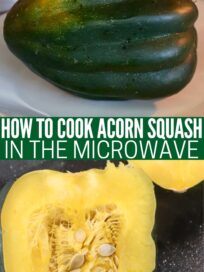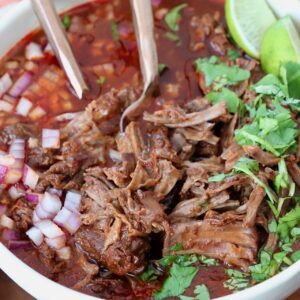How To Cook Acorn Squash
This post may contain affiliate links.
Learn how to cook acorn squash with this easy step-by-step guide! Acorn squash can be roasted in the oven, in an air fryer or cooked quickly in the microwave. It’s delicious stuffed with other roasted veggies, pureed into soup or simply seasoned and served as a side dish.

Table of contents
The perfect mix of savory and sweet, acorn squash should definitely be part of your fall and winter menus! It’s a type of gourd that is related to pumpkins, butternut squash and zucchini.
It’s easy enough to prepare in the microwave, oven, or air fryer to serve it as a side dish, or as part of a recipe.
Dress it up with a variety of seasonings and toppings, blend it into soups, top salads, incorporate it into casseroles or stuff it with extra veggies or roasted meats. No matter how you serve it, you’re going to fall in love with this delicious variety of squash!


Preparing acorn squash for cooking
If cooking the acorn squash in the oven or an air fryer, follow these steps to prepare the squash before roasting. If cooking the squash in the microwave, you’ll want to keep it whole and follow the directions in the next section.
I tested each of these methods using an average size squash, 1 ½ – 2 pounds in size. If the squash you have is smaller or larger, you may have to adjust the cooking times either up or down.
- Cut the acorn squash in half from stem to root. The skin on acorn squash is very thin so it’s much easier to cut than other squash, like spaghetti squash.
- Use a fork to remove the seeds from the middle of the squash.
- Brush the flesh of the squash with olive oil, then season with salt. You can also add other seasonings at this time. More on that below.


How to cook it in an air fryer
- After you’ve followed the steps above to prepare the squash, place it cut side up in an air fryer.
- Cook at 400°F for 20 minutes.



How to cook it in the microwave
- Use a fork to poke holes all over the squash to release steam as it cooks in the microwave.
- Place the squash on a microwave-safe plate. Microwave for 4 minutes, use tongs or an oven mitt to flip the squash over on the plate. Microwave for an additional 4 minutes.
- Remove from the microwave and slice in half from root to stem. Use a fork to remove the seeds from the middle of the squash. Season and dig in, or use in your favorite acorn squash recipe.

How to roast it in the oven
- Follow the instructions above to prepare the squash, then place it cut side up on a foil-lined baking sheet.
- Roast in a preheated 400°F oven for 35-45 minutes.
What’s the best way to cook acorn squash
- Fastest: the microwave only takes 8 minutes to cook a whole acorn squash, making it the fastest method. If you’re in a hurry, this is the method I’d recommend.
- Best texture: it’s a tie, between the air fryer and oven. The texture of acorn squash cooked in both of these appliances is very similar. It’s tender, with a slightly crispy, caramelized texture on the top layer of squash.
- Best overall: if you’re only cooking one acorn squash, I’d recommend the air fryer. It cooks in almost half the time as the oven and the taste and texture are almost identical to the squash cooked in the oven. If you’re roasting more than one squash, I would recommend the oven for the best texture and the ability to cook several squash at a time.
Pro tips
- You’ll know when the squash is done when you can easily insert a fork in the flesh. You want it tender, yet not mushy. If the squash is already cut in half, you can easily test if it is done by sticking a fork in the flesh of the squash. If it’s fork-tender, it’s cooked and ready to eat.
- To avoid watery acorn squash, do not over cook it. Overcooked squash will become watery and mushy. Salting the squash before roasting it also helps to pull out some of the moisture to avoid watery squash.
- You do not need to peel acorn squash before cooking. You can easily scoop the flesh out of the squash once it’s cooked. You can also easily peel the skin from the squash, once it’s cooled to the touch, or by using heat-proof gloves.
- Use something sharp to deseed the squash. I like using a fork to scrape out the seeds, however a grapefruit spoon is another helpful tool.
- If you are having trouble cutting the squash in half, try this trick. Use a sharp knife to carefully pop off the stem by wedging the tip of the knife under and prying it up, or simply slice off the top of the acorn squash. Once the top of the squash is removed, place the squash on a cutting board cut-side down. This allows you to push the knife through with more steadiness.

Storing and freezing
You can store the cooked flesh of the quash in the refrigerator or freezer for leftovers or meal prep.
Let the squash cool to room temperature. Seal it in an airtight container. Refrigerate for up to 7 days.
You can also freeze cooked acorn squash for up to 8 months. It is best to vacuum seal to avoid freezer burn. If you don’t have a vacuum sealer, simply place it in a freezer safe zip-top bag and squeeze out as much air as possible before sealing.
How to season the squash
You can always keep things simple with salt and pepper, but it’s fun to get creative with the flavors. Try out a sprinkle of any of these seasoning options.
- Brown sugar + cinnamon
- Paprika + cayenne pepper
- Pumpkin pie spice
- Cumin + paprika
- Curry powder
- Rosemary
- Italian seasoning
- Sage + thyme
- Garlic powder + onion powder
- Chili seasoning

Recipes to make with it
One of the great things about winter squash is that they are interchangeable in recipes! Use this roasted acorn squash, no matter the method, to make any of these delicious recipes. Simply sub out the butternut squash for acorn squash.
- Stuffed Acorn Squash with Brussels Sprouts (pictured above)
- Acorn Squash Soup
- Chai Spiced Butternut Squash Soup
- Butternut Squash Sausage Strudel
- Butternut Squash Mac and Cheese
- Roasted Squash Casserole with Maple Nut Praline
- Add it to salads, like this Roasted Butternut Squash Spinach Kale Salad.
- Pour some Butternut Squash Pasta Sauce all over your favorite noodles, or try this Brown Butter Acorn Squash Pasta.
- Pair with Mexican inspired flavors, in recipes like Butternut Squash Tacos or this Mexican Roasted Squash Bowl.
- Stuff the inside with wild rice and greens for a light and fresh meal!
- You can also simply dress it up with bacon, sausage, pecans, walnuts, dark greens, or extra veggies.
Tools for this recipe

More kitchen tutorials
Don’t miss these other quick and easy cooking how-to posts!
How To Cook Acorn Squash
Video
Instructions
Oven
- Preheat the oven to 400°F.
- Cut the squash in half from stem to root.
- Use a fork to scrape out the seeds from the inside of the squash.
- Brush ½ teaspoon olive oil on the inside flesh of each half of acorn squash and season each half with ¼ teaspoon salt.
- Place the squash, flesh side up, on a foil-lined baking sheet.
- Bake at 400°F for 35-45 minutes, or until the flesh is fork-tender.
Microwave
- Leave the acorn squash whole. Use a fork to poke several holes in the squash to release steam as it cooks in the microwave.
- Place the squash on a microwave-safe plate and into the microwave for 4 minutes.
- Use tongs or an oven mitt to flip the squash on the plate in the microwave.
- Microwave for an additional 4 minutes.
- Remove from the microwave and cut the acorn squash in half from stem to root, use a fork to remove the seeds, then serve the squash.
Air Fryer
- Cut the acorn squash in half from stem to root.
- Use a fork to scrape out all of the seeds from both sides of the squash. Discard the seeds.
- Brush ½ teaspoon olive oil on the inside flesh of each half of acorn squash and season each half with ¼ teaspoon salt.
- Place cut side up in an air fryer basket, cook at 400°F for 20 minutes.
Notes
- Each of these methods were tested using an average size squash, 1 ½ – 2 pounds in size. If the squash you have is smaller or larger, you may have to adjust the cooking times either up or down.
- You’ll know when the squash is done when you can easily insert a fork in the flesh. You want it tender, yet not mushy. If the squash is already cut in half, you can easily test if it is done by sticking a fork in the flesh of the squash. If it’s fork-tender, it’s done cooking and ready to eat.
- To avoid watery acorn squash, do not over cook it. Overcooked squash will become watery and mushy. Salting the squash before roasting it also helps to pull out some of the moisture to avoid watery squash.
- You do not need to peel acorn squash before cooking, as the flesh will easily scoop out of the squash once it’s cooked. You can also easily peel the skin from the squash, once it’s cooled to the touch, or by using heat-proof gloves.
- Once the squash is cooked and the flesh is removed from the skin, you can store it in the refrigerator or freezer. Seal it in an airtight container. Refrigerate for up to 7 days or freeze for up to 8 months.
Nutrition Facts
We are a participant in the Amazon Services LLC Associates Program, an affiliate advertising program designed to provide a means for sites to earn advertising fees by advertising and linking to amazon.com.






















3 Comments on “How To Cook Acorn Squash”
I loved this guide on cooking acorn squash! I never thought about using the air fryer, and it turned out perfectly crispy. Thanks for the tips on seasoning too—I can’t wait to try them all!
I never knew there were so many ways to cook acorn squash! I usually just roast it, but now I’m excited to try it in the air fryer. Your tips on seasoning really helped too—can’t wait to give it a try!
This post is exactly what I needed! I always struggled with cooking acorn squash, but your tips for the oven and air fryer are so helpful. I can’t wait to try the recipes you suggested—especially the maple glaze. Thanks for sharing!